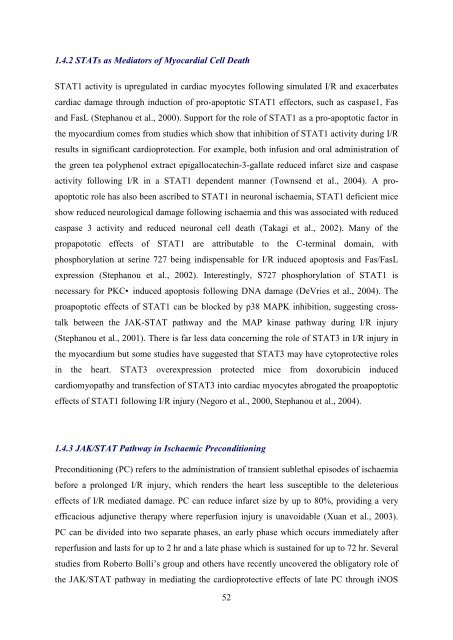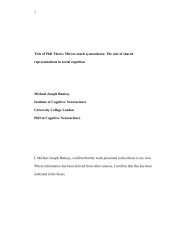Investigating the role of the JAK/STAT and MAPK ... - UCL Discovery
Investigating the role of the JAK/STAT and MAPK ... - UCL Discovery
Investigating the role of the JAK/STAT and MAPK ... - UCL Discovery
You also want an ePaper? Increase the reach of your titles
YUMPU automatically turns print PDFs into web optimized ePapers that Google loves.
1.4.2 <strong>STAT</strong>s as Mediators <strong>of</strong> Myocardial Cell Death<br />
<strong>STAT</strong>1 activity is upregulated in cardiac myocytes following simulated I/R <strong>and</strong> exacerbates<br />
cardiac damage through induction <strong>of</strong> pro-apoptotic <strong>STAT</strong>1 effectors, such as caspase1, Fas<br />
<strong>and</strong> FasL (Stephanou et al., 2000). Support for <strong>the</strong> <strong>role</strong> <strong>of</strong> <strong>STAT</strong>1 as a pro-apoptotic factor in<br />
<strong>the</strong> myocardium comes from studies which show that inhibition <strong>of</strong> <strong>STAT</strong>1 activity during I/R<br />
results in significant cardioprotection. For example, both infusion <strong>and</strong> oral administration <strong>of</strong><br />
<strong>the</strong> green tea polyphenol extract epigallocatechin-3-gallate reduced infarct size <strong>and</strong> caspase<br />
activity following I/R in a <strong>STAT</strong>1 dependent manner (Townsend et al., 2004). A pro-<br />
apoptotic <strong>role</strong> has also been ascribed to <strong>STAT</strong>1 in neuronal ischaemia, <strong>STAT</strong>1 deficient mice<br />
show reduced neurological damage following ischaemia <strong>and</strong> this was associated with reduced<br />
caspase 3 activity <strong>and</strong> reduced neuronal cell death (Takagi et al., 2002). Many <strong>of</strong> <strong>the</strong><br />
propapototic effects <strong>of</strong> <strong>STAT</strong>1 are attributable to <strong>the</strong> C-terminal domain, with<br />
phosphorylation at serine 727 being indispensable for I/R induced apoptosis <strong>and</strong> Fas/FasL<br />
expression (Stephanou et al., 2002). Interestingly, S727 phosphorylation <strong>of</strong> <strong>STAT</strong>1 is<br />
necessary for PKC induced apoptosis following DNA damage (DeVries et al., 2004). The<br />
proapoptotic effects <strong>of</strong> <strong>STAT</strong>1 can be blocked by p38 <strong>MAPK</strong> inhibition, suggesting cross-<br />
talk between <strong>the</strong> <strong>JAK</strong>-<strong>STAT</strong> pathway <strong>and</strong> <strong>the</strong> MAP kinase pathway during I/R injury<br />
(Stephanou et al., 2001). There is far less data concerning <strong>the</strong> <strong>role</strong> <strong>of</strong> <strong>STAT</strong>3 in I/R injury in<br />
<strong>the</strong> myocardium but some studies have suggested that <strong>STAT</strong>3 may have cytoprotective <strong>role</strong>s<br />
in <strong>the</strong> heart. <strong>STAT</strong>3 overexpression protected mice from doxorubicin induced<br />
cardiomyopathy <strong>and</strong> transfection <strong>of</strong> <strong>STAT</strong>3 into cardiac myocytes abrogated <strong>the</strong> proapoptotic<br />
effects <strong>of</strong> <strong>STAT</strong>1 following I/R injury (Negoro et al., 2000, Stephanou et al., 2004).<br />
1.4.3 <strong>JAK</strong>/<strong>STAT</strong> Pathway in Ischaemic Preconditioning<br />
Preconditioning (PC) refers to <strong>the</strong> administration <strong>of</strong> transient sublethal episodes <strong>of</strong> ischaemia<br />
before a prolonged I/R injury, which renders <strong>the</strong> heart less susceptible to <strong>the</strong> deleterious<br />
effects <strong>of</strong> I/R mediated damage. PC can reduce infarct size by up to 80%, providing a very<br />
efficacious adjunctive <strong>the</strong>rapy where reperfusion injury is unavoidable (Xuan et al., 2003).<br />
PC can be divided into two separate phases, an early phase which occurs immediately after<br />
reperfusion <strong>and</strong> lasts for up to 2 hr <strong>and</strong> a late phase which is sustained for up to 72 hr. Several<br />
studies from Roberto Bolli’s group <strong>and</strong> o<strong>the</strong>rs have recently uncovered <strong>the</strong> obligatory <strong>role</strong> <strong>of</strong><br />
<strong>the</strong> <strong>JAK</strong>/<strong>STAT</strong> pathway in mediating <strong>the</strong> cardioprotective effects <strong>of</strong> late PC through iNOS<br />
52
















